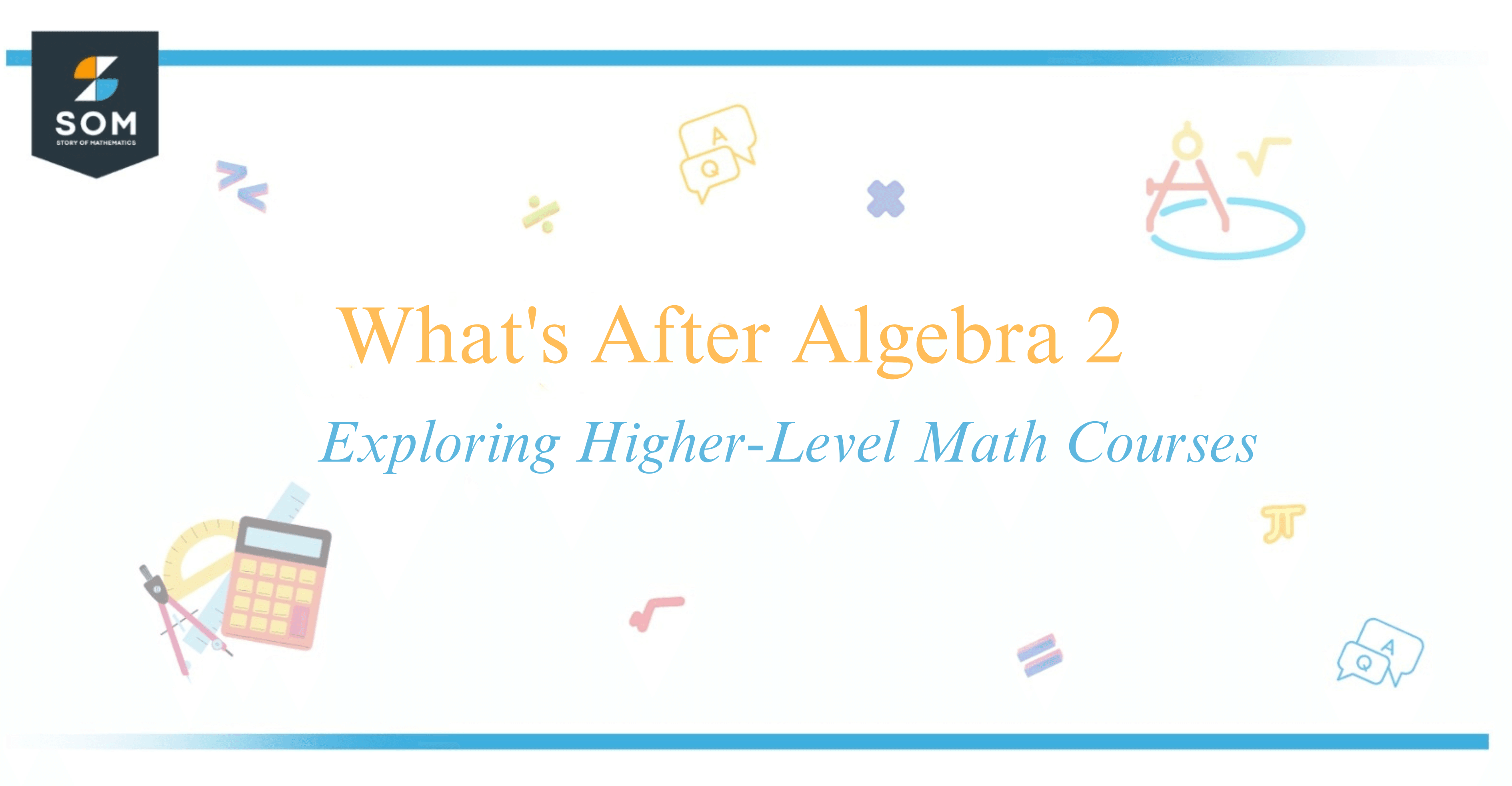JUMP TO TOPIC

The Algebra 2 is commonly the final course in the sequence of high school algebra, laying the groundwork for higher-level math classes. In my high school journey, mastering Algebra 2 was a pivotal moment because it signified a readiness to tackle more abstract and complex mathematical concepts.
Topics such as linear equations, polynomials, and exponential functions were all covered, providing a solid foundation for the next steps in mathematical learning.
Upon completion of Algebra 2, I found myself at a crossroads, ready to advance to a variety of math classes offered in high school. These courses include Precalculus, which serves as the bridge to Calculus, and other options like Trigonometry, Statistics, or even Advanced Placement courses in these areas.
This curriculum prepares students with the skills necessary to not only excel in their current studies but also to pursue STEM-related courses in college.
Now, as I reflect on this academic transition, I realize it’s a time of both excitement and significant educational growth, a gateway to uncovering the mysteries and beauty hidden within the universe’s numbers and equations.
Building on Algebra 2
After mastering the principles of Algebra 2, I find myself at a crossroads, selecting the next mathematical journey to embark on. The path isn’t singular; there are several options that build upon the algebraic foundations I’ve laid.
Trigonometry is a course that weaves itself into Algebra 2 through the study of functions. It explores the relationships within triangles, circles, and oscillations, key for comprehending periodic phenomena. Here, identities like the Pythagorean theorem, ( $\sin^2(\theta) + \cos^2(\theta) = 1$ ), unravel the intricate links between angles and sides.
Moving to Precalculus, this course is a comprehensive preparation for calculus. It consolidates my understanding of functions, both algebraically and graphically, and introduces new concepts essential for higher math.
The curriculum often encompasses:
- Functions: I encounter even deeper insights into polynomial, rational, and logarithmic functions, crucial for calculus.
- Sequences and Series: I learn to decipher patterns in numbers, which primes my analytical skills for calculus by examining arithmetic and geometric progressions with formulas like the nth term of a geometric sequence, $a_n = a_1 \cdot r^{(n-1)}$.
| Concept | Focus | Example |
|---|---|---|
| Trigonometry | Angles, triangles, and periodic functions | $\theta$ in $\sin(\theta)$ |
| Precalculus | Functions, analysis, and introductory calculus concepts | Exploring limits and asymptotes |
My progress through these advanced topics fortifies my mathematical toolkit—expanding my capacity to tackle challenging problems and laying the groundwork for Calculus.
It’s a journey of connection, where every new concept intertwines with Algebra 2, enabling a deeper understanding and application in real-world scenarios.
Advanced Placement Mathematics
After completing Algebra 2, I often consider enrolling in Advanced Placement (AP) mathematics courses.

These provide a solid foundation for college-level math and can potentially earn me college credit.
The choices typically include:
- AP Calculus AB: This is the introductory calculus course, covering differential and integral calculus. It includes topics like limits, derivatives, integrals, and the Fundamental Theorem of Calculus. For example, the slope of a curve at a point is given by the derivative ( f'(x) )
- AP Calculus BC: This course goes beyond Calculus AB by covering additional topics such as sequences and series, parametric, polar, and vector functions, as well as advanced integration techniques.
- AP Statistics: This course focuses on collecting, analyzing, interpreting, and presenting data. It encompasses four main themes: exploring data, sampling and experimentation, anticipating patterns, and statistical inference. Probability plays a significant role here, with concepts like the Binomial Theorem ( (a + b)^n )
| AP Course | Focus Area | Key Topics |
|---|---|---|
| AP Calculus AB | Introductory Calculus | Limits,derivatives,integrals |
| AP Calculus BC | Advanced Calculus | Series, Parametric Equations |
| AP Statistics | Data Analysis | Probability, Inference |
Choosing between these courses depends on my academic goals and the prerequisites required by my high school. Many students who excel in AP Calculus BC or AP Statistics find themselves well-prepared for further studies in fields that are heavily reliant on mathematics.
Exploring Calculus and Beyond
After mastering Algebra 2, my journey into higher mathematics led me to Calculus, a fascinating field that explores the rates of change and accumulation. Calculus can be broadly divided into two main branches: Differential Calculus and Integral Calculus.
Differential Calculus deals with the concept of a derivative, which represents the rate at which a function changes at any given point. It’s beautifully encapsulated by the limit definition of a derivative: $$ f'(x) = \lim_{h \to 0} \frac{f(x+h) – f(x)}{h} $$
On the other side, Integral Calculus focuses on finding the total accumulation of quantities. This might be the area under a curve or the accumulated value of a continuous function over an interval.
The fundamental theorem of calculus neatly ties both branches together, concentrating on the anti-derivative or the integral: $$ \int_a^b f(x) , dx = F(b) – F(a) $$
Linear Algebra is another step after calculus, and it introduces me to the study of vectors, vector spaces, and linear equations. Equations in linear algebra take the general form: $$ ax + by = c $$
It’s vital for an array of applications, including computer science, engineering, and data science.
Heading into more abstract realms, Analysis offers a deeper dive into the infinite processes that underpin calculus. It rigorously examines limits, sequences, and continuity.
| Field | Focus |
|---|---|
| Calculus | Rates of change & accumulation |
| Linear Algebra | Vectors and systems of linear equations |
| Analysis | Rigorous study of infinite processes |
By exploring these advanced areas, I build a stronger mathematical foundation, preparing me for complex problem-solving and theoretical challenges beyond Algebra 2.
Mathematics in Real-world Applications
When I consider real-world applications of mathematics after Algebra 2, I find it essential to look at how it comes into play in various scenarios. In my high school schedule, mathematics transcends the classroom, connecting to more advanced courses and tests such as SAT and ACT, which require strong arithmetic and algebraic skills.
| Application | Relevance |
|---|---|
| Modeling | I use equations to depict real-life situations and make predictions. |
| Placement Test | My proficiency impacts the math courses I can enroll in for college. |
| Data Analysis | Understanding statistics is crucial for interpreting information. |
For instance, in the area of modeling, these advanced mathematical skills enable me to create equations that represent complex scenarios. If I’m tasked with predicting the growth of a plant in biology, I’d use the formula ( y = mx + b ), where m represents the growth rate, b is the initial height, and y stands for the height at time x.
This application supports the Common Core Standards that advocate for the practical use of math.
Moreover, knowledge of probability and statistics allows me to decipher and utilize data effectively. In my everyday life, this could be as simple as calculating the best deals when shopping. For example, if an item is on sale for 20% off, the discounted price can be determined by the formula ( $\text{final price}$ = $\text{original price} \times (1-0.20)$ ).
High school math courses, geared towards real-world application, ensure that I am well-prepared for both college and career paths. Whether it is through standardized testing or everyday problem-solving, the math I’ve learned after Algebra 2 is a fundamental tool that I apply regularly.
Conclusion
After navigating the waters of Algebra 1 and 2, I am met with a variety of paths in my mathematical journey. Calculus often serves as my next step, delving into derivatives and integrals that are the foundation for understanding changes and areas under curves. The equation of a derivative, for instance, can be written as $\frac{df(x)}{dx}$, while the integral is represented by $\int f(x)dx$.
Should I prefer a more gradual transition, Precalculus is a suitable choice. It refines my skills further, bridging the gap between Algebra and Calculus, and introducing me to concepts like the trigonometric functions and complex numbers.
Moreover, disciplines such as Linear Algebra and Differential Equations are significant for those of us with an inclination toward engineering or physical sciences. They introduce vectors with equations such as $\vec{v} = a\hat{i} + b\hat{j}$, and differential equations like $\frac{d^2y}{dx^2} + p(x)\frac{dy}{dx} + q(x)y = 0$.
My road may take an applied turn into Statistics, where data analysis becomes paramount, or venture into Discrete Mathematics where I’ll explore logic, set theory, and number theory. Each of these courses equips me with critical thinking and problem-solving skills.
Navigating through these advanced courses, I am not only preparing for college-level mathematics but also laying the groundwork for potential STEM careers. No matter the direction, each class builds on my knowledge and opens doors to new fields of discovery and innovation.
